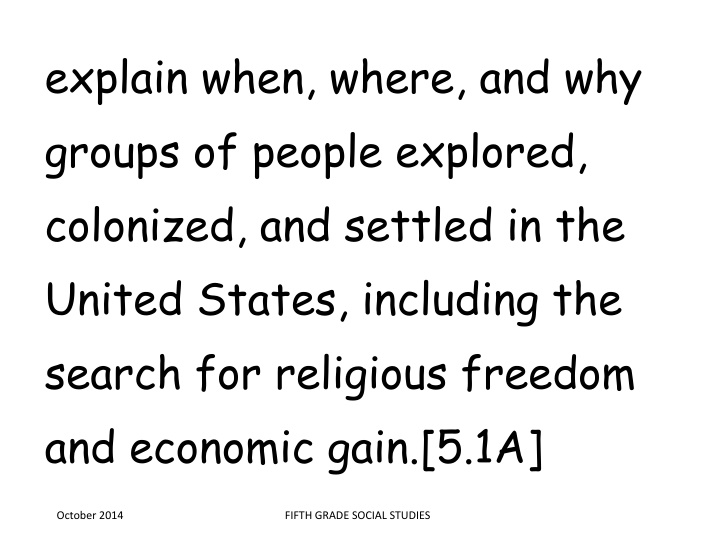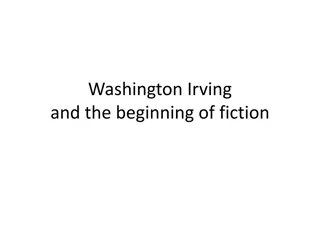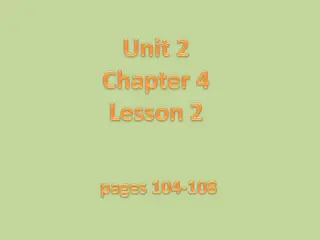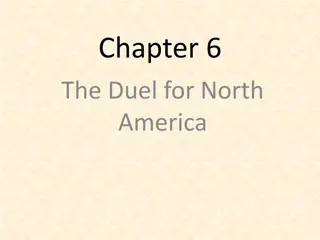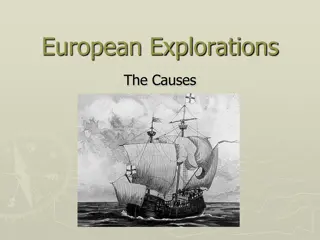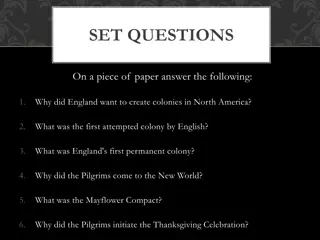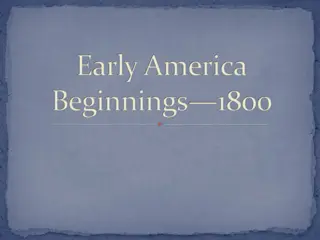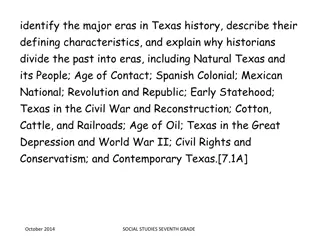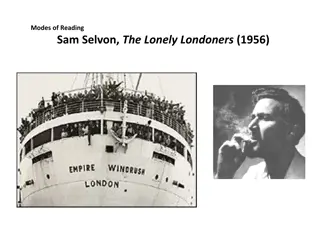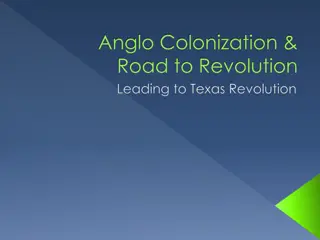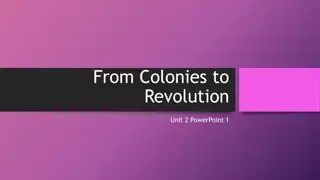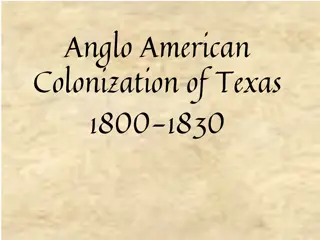Early American Exploration and Colonization
Groups of people explored, colonized, and settled in the United States for reasons such as religious freedom and economic gain. Significant individuals during the colonial period, causes and effects of events prior to and during the American Revolution, Founding Fathers and Patriot heroes, results of the American Revolution, creation of the U.S. Constitution, and the War of 1812 are highlighted in this educational content.
Download Presentation

Please find below an Image/Link to download the presentation.
The content on the website is provided AS IS for your information and personal use only. It may not be sold, licensed, or shared on other websites without obtaining consent from the author.If you encounter any issues during the download, it is possible that the publisher has removed the file from their server.
You are allowed to download the files provided on this website for personal or commercial use, subject to the condition that they are used lawfully. All files are the property of their respective owners.
The content on the website is provided AS IS for your information and personal use only. It may not be sold, licensed, or shared on other websites without obtaining consent from the author.
E N D
Presentation Transcript
explain when, where, and why groups of people explored, colonized, and settled in the United States, including the search for religious freedom and economic gain.[5.1A] October 2014 FIFTH GRADE SOCIAL STUDIES
describe the accomplishments of significant individuals during the colonial period, including William Bradford, Anne Hutchinson, William Penn, John Smith, John Wise, and Roger Williams.[5.1B] October 2014 FIFTH GRADE SOCIAL STUDIES
identify and analyze the causes and effects of events prior to and during the American Revolution, including the French and Indian War and the Boston Tea Party.[5.2A] October 2014 FIFTH GRADE SOCIAL STUDIES
identify the Founding Fathers and Patriot heroes, including John Adams, Samuel Adams, Benjamin Franklin, Nathan Hale, Thomas Jefferson, the Sons of Liberty, and George Washington, and their motivations and contributions during the revolutionary period.[5.2B] October 2014 FIFTH GRADE SOCIAL STUDIES
summarize the results of the American Revolution, including the establishment of the United States and the development of the U.S. military.[5.2C] October 2014 FIFTH GRADE SOCIAL STUDIES
identify the issues that led to the creation of the U.S. Constitution, including the weaknesses of the Articles of Confederation.[5.3A] October 2014 FIFTH GRADE SOCIAL STUDIES
identify the contributions of individuals, including James Madison, and others such as George Mason, Charles Pinckney, and Roger Sherman who helped create the U.S. Constitution [5.3B] October 2014 FIFTH GRADE SOCIAL STUDIES
describe the causes and effects of the War of 1812.[5.4A] October 2014 FIFTH GRADE SOCIAL STUDIES
identify and explain how changes resulting from the Industrial Revolution led to conflict among sections of the United States.[5.4B] October 2014 FIFTH GRADE SOCIAL STUDIES
identify reasons people moved west.[5.4C] October 2014 FIFTH GRADE SOCIAL STUDIES
identify significant events and concepts associated with U.S. territorial expansion, including the Louisiana Purchase, the expedition of Lewis and Clark, and Manifest Destiny.[5.4D] October 2014 FIFTH GRADE SOCIAL STUDIES
identify the causes of the Civil War, including sectionalism, states' rights, and slavery, and the effects of the Civil War, including Reconstruction and the 13th, 14th, and 15th amendments to the U.S. Constitution.[5.4E] October 2014 FIFTH GRADE SOCIAL STUDIES
explain how industry and the mechanization of agriculture changed the American way of life.[5.4F] October 2014 FIFTH GRADE SOCIAL STUDIES
identify the challenges, opportunities, and contributions of people from various American Indian and immigrant groups.[5.4G] October 2014 FIFTH GRADE SOCIAL STUDIES
analyze various issues and events of the 20th century such as industrialization, urbanization, increased use of oil and gas, the Great Depression, the world wars, the civil rights movement, and military actions.[5.5A] October 2014 FIFTH GRADE SOCIAL STUDIES
analyze various issues and events of the 21st century such as the War on Terror and the 2008 presidential election.[5.5B] October 2014 FIFTH GRADE SOCIAL STUDIES
identify the accomplishments of individuals and groups such as Jane Addams, Susan B. Anthony, Dwight Eisenhower, Martin Luther King Jr., Rosa Parks, Cesar Chavez, Franklin D. Roosevelt, Ronald Reagan, Colin Powell, the Tuskegee Airmen, and the 442nd Regimental Combat Team who have made contributions to society in the areas of civil rights, women's rights, military actions, and politics.[5.5C] October 2014 FIFTH GRADE SOCIAL STUDIES
apply geographic tools, including grid systems, legends, symbols, scales, and compass roses, to construct and interpret maps.[5.6A] October 2014 FIFTH GRADE SOCIAL STUDIES
translate geographic data into a variety of formats such as raw data to graphs and maps.[5.6B] October 2014 FIFTH GRADE SOCIAL STUDIES
describe a variety of regions in the United States such as political, population, and economic regions that result from patterns of human activity.[5.7A] October 2014 FIFTH GRADE SOCIAL STUDIES
describe a variety of regions in the United States such as landform, climate, and vegetation regions that result from physical characteristics such as the Great Plains, Rocky Mountains, and Coastal Plains.[5.7B] October 2014 FIFTH GRADE SOCIAL STUDIES
locate on a map important political features such as the ten largest urban areas in the United States, the 50 states and their capitals, and regions such as the Northeast, the Midwest, and the Southwest [5.7C] October 2014 FIFTH GRADE SOCIAL STUDIES
locate on a map important physical features such as the Rocky Mountains, Mississippi River, and Great Plains.[5.7D] October 2014 FIFTH GRADE SOCIAL STUDIES
identify and describe the types of settlement and patterns of land use in the United States.[5.8A] October 2014 FIFTH GRADE SOCIAL STUDIES
explain the geographic factors that influence patterns of settlement and the distribution of population in the United States, past and present.[5.8B] October 2014 FIFTH GRADE SOCIAL STUDIES
analyze the reasons for the location of cities in the United States, including capital cities, and explain their distribution, past and present.[5.8C] October 2014 FIFTH GRADE SOCIAL STUDIES
describe how and why people have adapted to and modified their environment in the United States, past and present, such as the use of human resources to meet basic needs.[5.9A] October 2014 FIFTH GRADE SOCIAL STUDIES
analyze the positive and negative consequences of human modification of the environment in the United States, past and present.[5.9B] October 2014 FIFTH GRADE SOCIAL STUDIES
explain the economic patterns of early European colonists.[5.10A] October 2014 FIFTH GRADE SOCIAL STUDIES
identify major industries of colonial America.[5.10B] October 2014 FIFTH GRADE SOCIAL STUDIES
describe the development of the free enterprise system in colonial America and the United States.[5.11A] October 2014 FIFTH GRADE SOCIAL STUDIES
describe how the free enterprise system works in the United States.[5.11B] October 2014 FIFTH GRADE SOCIAL STUDIES
give examples of the benefits of the free enterprise system in the United States.[5.11C] October 2014 FIFTH GRADE SOCIAL STUDIES
explain how supply and demand affects consumers in the United States.[5.12A] October 2014 FIFTH GRADE SOCIAL STUDIES
evaluate the effects of supply and demand on business, industry, and agriculture, including the plantation system, in the United States.[5.12B] October 2014 FIFTH GRADE SOCIAL STUDIES
compare how people in different parts of the United States earn a living, past and present.[5.13A] October 2014 FIFTH GRADE SOCIAL STUDIES
identify and explain how geographic factors have influenced the location of economic activities in the United States.[5.13B] October 2014 FIFTH GRADE SOCIAL STUDIES
analyze the effects of immigration, migration, and limited resources on the economic development and growth of the United States.[5.13C] October 2014 FIFTH GRADE SOCIAL STUDIES
describe the impact of mass production, specialization, and division of labor on the economic growth of the United States.[5.13D] October 2014 FIFTH GRADE SOCIAL STUDIES
explain the impact of American ideas about progress and equality of opportunity on the economic development and growth of the United States.[5.13E] October 2014 FIFTH GRADE SOCIAL STUDIES
identify and compare the systems of government of early European colonists, including representative government and monarchy.[5.14A] October 2014 FIFTH GRADE SOCIAL STUDIES
identify examples of representative government in the American colonies, including the Mayflower Compact and the Virginia House of Burgesses.[5.14B] October 2014 FIFTH GRADE SOCIAL STUDIES
identify the key elements and the purposes and explain the importance of the Declaration of Independence.[5.15A] October 2014 FIFTH GRADE SOCIAL STUDIES
explain the purposes of the U.S. Constitution as identified in the Preamble.[5.15B] October 2014 FIFTH GRADE SOCIAL STUDIES
explain the reasons for the creation of the Bill of Rights and its importance.[5.15C] October 2014 FIFTH GRADE SOCIAL STUDIES
identify and explain the basic functions of the three branches of government.[5.16A] October 2014 FIFTH GRADE SOCIAL STUDIES
identify the reasons for and describe the system of checks and balances outlined in the U.S. Constitution.[5.16B] October 2014 FIFTH GRADE SOCIAL STUDIES
distinguish between national and state governments and compare their responsibilities in the U.S. federal system.[5.16C] October 2014 FIFTH GRADE SOCIAL STUDIES
explain various patriotic symbols, including Uncle Sam, and political symbols such as the donkey and elephant.[5.17A] October 2014 FIFTH GRADE SOCIAL STUDIES
sing or recite "The Star- Spangled Banner" and explain its history.[5.17B] October 2014 FIFTH GRADE SOCIAL STUDIES
